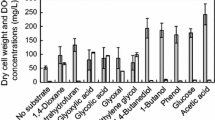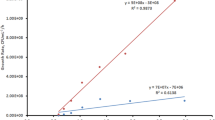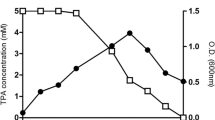Abstract
This work has a focus on adaptive capabilities of the actinobacterium Rhodococcus ruber IEGM 326 to cope with drotaverine hydrochloride (DH), a known pharmaceutical pollutant. Cultivation of R. ruber in a nitrogen-limited medium with incubation at the ambient temperature resulted in the formation of cyst-like dormant cells (CLDCs). They maintained viability for 2–7 months, possessed the undetectable respiratory activity and elevated resistance to heating, and had a specific morphology. CLDCs are regarded to ensure long-term survival in various habitats and may be used as storage formulations. R. ruber IEGM 326 was tolerant to DH (MIC, 200 mg/l) and displayed different abilities to degrade this compound, depending on inoculum, temperature, and the presence of glucose as co-oxidized substrate. Thus, the loss of DH (20 mg/l) over 48 h at the optimal temperature (27 ± 2 °C) was 5–8 % in the absence of glucose after inoculating with vegetative cells. The addition of glucose (5 g/l) increased DH degradation up to 46 %. Noteworthy, CLDCs as inoculum were advantageous over vegetative cells to degrade DH at the non-optimal temperature (35 ± 2 °C) at reduced bulk respiratory activity. The obtained results are promising to improve the biodegrading capabilities of other Rhodococcus strains.


Similar content being viewed by others
References
Adam W, Luckacs Z, Kahle C, Saha-Möller CR, Schreier P (2001) Biocatalytic asymmetric hydroxylation of hydrocarbons by free and immobilized Bacillus megaterium cells. J Mol Catal B Enzym 11:377–385. doi:10.1016/S1381-1177(00)00028-X
Alvarez HM, Silva RA, Cesari AC, Zamit AL, Peressutti SR, Reichelt R, Keller U, Malkus U, Rasch C, Maskow T, Mayer F, Steinbüchel A (2004) Physiological and morphological responses of the soil bacterium Rhodococcus opacus strain PD630 to water stress. FEMS Microbiol Ecol 50(2):75–86. doi:10.1016/j.femsec.2004.06.002
Anuchin AM, Mulyukin AL, Suzina NE, Duda VI, El’-Registan GI, Kaprelyants AS (2009) Dormant forms of Mycobacterium smegmatis with distinct morphology. Microbiology 155:1071–1079. doi:10.1099/mic.0.023028-0
Bell KS, Kuyukina MS, Heidbrink S, Philp JC, Aw DWJ, Ivshina IB, Christofi N (1999) Identification and environmental detection of Rhodococcus species by 16S rDNA-targeted PCR. J Appl Microbiol 87:472–480. doi:10.1046/j.1365-2672.1999.00824.x
Bessems JG, Vermeulen NP (2001) Paracetamol (acetaminophen)-induced toxicity: molecular and biochemical mechanisms, analogues and protective approaches. Crit Rev Toxicol 31(1):55–138
Celiz MD, Tso J, Aga DS (2009) Pharmaceutical metabolites in the environment: analytical challenges and ecological risks. Environ Toxicol Chem 28(12):2473–2484. doi:10.1897/09-173.1
de Carvalho CCCR, Costa SC, Fernandes P, Couto I, Viveiros M (2014) Membrane transport systems and the biodegradation potential and pathogenicity of genus Rhodococcus. Front Physiol 5:133. doi:10.3389/fphys.2014.00133
de Carvalho CCCR, da Fonseca MMR (2005) The remarkable Rhodococcus erythropolis. Appl Microbiol Biotechnol 67:715–726. doi:10.1007/s00253-005-1932-3
Duca G, Boldescu V (2009) Pharmaceuticals and personal care products in the environment. In: Bahadir AM, Duca G (eds) The role of ecological chemistry in pollution research and sustainable development. Springer, Dordrecht, pp 27–35. doi:10.1007/978-90-481-2903-4_3
El’-Registan GI, Mulyukin AL, Nikolaev YuA, Suzina NE, Gal’chenko VF, Duda VI (2006) Adaptogenic functions of extracellular autoregulators of microorganisms. Microbiology 75(4):380–389. doi:10.1134/S0026261706040035
Endreffy E, Boda D (1983) Effect of drugs used in obstetrics on the constriction by oxygen of the ductus arteriosus of the rabbit fetus. Acta Paediatr Hung 24(3):281–285
Gauthier H, Yargeau V, Cooper DG (2010) Biodegradation of pharmaceuticals by Rhodococcus rhodochrous and Aspergillus niger by co-metabolism. Sci Total Environ 408:1701–1706. doi:10.1016/j.scitotenv.2009.12.012
Ivshina IB (2012) Current situation and challenges of specialized microbial resource centres in Russia. Microbiology 81(5):509–516. doi:10.1134/S0026261712050098
Ivshina IB, Kuyukina MS, Krivoruchko AV, Plekhov OA, Naimark OB, Podorozhko EA, Lozinsky VI (2013) Biosurfactant-enhanced immobilization of hydrocarbon-oxidizing Rhodococcus ruber on sawdust. Appl Microbiol Biotechnol 97(12):5315–5327. doi:10.1007/s00253-013-4869-y
Ivshina IB, Kuyukina MS, Philp JC, Christofi N (1998) Oil desorption from mineral and organic materials using biosurfactant complexes produced by Rhodococcus species. World J Microbiol Biotechnol 14:711–717
Ivshina IB, Peshkur TA, Korobov VP (2002) Efficient uptake of cesium ions by Rhodococcus cells. Mikrobiologiia 71(3):357–361. doi:10.1023/a:1015875216095
Ivshina IB, Vikhareva EV, Richkova MI, Mukhutdinova AN, Karpenko JuN (2012) Biodegradation of drotaverine hydrochloride by free and immobilized cells of Rhodococcus rhodochrous IEGM 608. World J Microbiol Biotechnol 28:2997–3006. doi:10.1007/s11274-012-1110-6
Iwabuchi N, Sunairi M, Anzai H, Nakajima M, Harayama S (2000) Relationships between colony morphotypes and oil tolerance in Rhodococcus rhodochrous. Appl Environ Microbiol 66(11):5073–5077. doi:10.1128/AEM.66.11.5073-5077.2000
Kim Y-U, Han J, Lee SS, Shimizu K, Tsutsumi Y, Kondo R (2007) Steroid 9α-hydroxylation during testosterone degradation by resting Rhodococcus equi cells. Arch Pharm Chem Life Sci 340:209–214. doi:10.1002/ardp.200600175
Kolomytseva MP, Solyanikova IP, Golovlev EL, Golovleva LA (2005) Heterogeneity of Rhodococcus opacus 1CP as a response to stress induced by chlorophenols. Appl Biochim Microbiol 41(5):474–479. doi:10.1007/s10438-005-0085-6
Kolpin DW, Furlong ET, Meyer MT, Thurman EM, Zaugg SD, Barber LB, Buxton HT (2002) Pharmaceuticals, hormones, and other organic wastewater contaminants in U.S. streams, 1999–2000: a national reconnaissance. Environ Sci Technol 36:1202–1211. doi:10.1021/es011055j
Kuyukina MS, Ivshina IB (2010) Rhodococcus biosurfactants: biosynthesis, properties, and potential application. In: Alvarez HM (ed) Biology of Rhodococcus, microbiology monographs, vol 16. Springer, Berlin, pp 291–313. doi:10.1007/978-3-642-12937-7_11
Lalumera GM, Calamari D, Galli P, Castiglioni S, Crosa G, Fanelli R (2004) Preliminary investigation on the environmental occurrence and effects of antibiotics used in aquaculture in Italy. Chemosphere 54:661–668. doi:10.1016/j.chemosphere.2003.08.001
Larkin MJ, Kulakov LA, Allen CCR (2005) Biodegradation and Rhodococcus: masters of catabolic versatility. Curr Opin Biotechnol 16:282–290
Larkin MJ, Kulakov LA, Allen CCR (2006) Biodegradation by members of the genus Rhodococcus: biochemistry, physiology, and genetic adaptation. Adv Appl Microbiol 59:1–29. doi:10.1016/S0065-2164(06)59001-X
Leilei Z, Mingxin H, Suiyi Z (2012) Biodegradation of p-nitrophenol by immobilized Rhodococcus sp. strain Y-1. Chem Biochem Eng Q 26(2):137–144
Lennon JT, Jones SE (2011) Microbial seed banks: the ecological and evolutionary implications of dormancy. Nat Rev Microbiol 9:119–130
Marchand P, Rosenfeld E, Erable B, Maugard T, Lamare S, Goubet I (2008) Coupled oxidation–reduction of butanol–hexanal by resting Rhodococcus erythropolis NCIMB 13064 cells in liquid and gas phases. Enzyme Microb Technol 43(6):423–430. doi:10.1016/j.enzmictec.2008.07.004
Martínková L, Uhnáková B, Pátek M, Nešvera J, Křen V (2009) Biodegradation potential of the genus Rhodococcus. Environ Int 35:162–177. doi:10.1006/j.envint.2008.07.018
Morita R (1982) Starvation-survival of heterotrophs in the marine environment. Adv Microb Ecol 6:171–178
Mulyukin AL, Kozlova AN, El’-Registan GI (2008) Properties of the phenotypic variants of Pseudomonas aurantiaca and P. fluorescens. Microbiology 77(6):681–690. doi:10.11134/S0026261708060052
Mulyukin AL, Kudykina YUK, Shleeva MO, Anuchin AM, Suzina NE, Danilevich VN, Duda VI, Kaprelyants AS, El’-Registan GI (2010) Intraspecies diversity of dormant forms of Mycobacterium smegmatis. Microbiology 79(4):461–471. doi:10.1134/S0026261710040089
Mulyukin AL, Suzina NE, Pogorelova AYu, Antonyuk LP, Duda VI, El’-Registan GI (2009) Diverse morphological types of dormant cells and conditions for their formation in Azospirillum brasilense. Microbiology 78(1):33–41. doi:10.1134/S0026261709010056
Nallapan Maniyam M, Sjahrir F, Ibrahim AL (2011) Bioremediation of cyanide by optimized resting cells of Rhodococcus strains isolated from Peninsular Malaysia. Int J Biosci Biochem Bioinform 1(2):98–101. doi:10.7763/IJBBB.2011.V1.18
Nallapan Maniyam M, Sjahrir F, Ibrahim AL, Cass AEG (2013) Biodegradation of cyanide by Rhodococcus UKMP-5M. Biologia 68(2):177–185. doi:10.2478/s11756-013-0158-6
Narvaez JFV, Jimenez CC (2012) Pharmaceutical products in the environment: sources, effects and risks. Vitae 19(1):93–108
Nikolaou A (2013) Pharmaceuticals and related compounds as emerging pollutants in water: analytical aspects. Global NEST J 15(1):1–12
Reynolds E (1963) The use of lead citrate at high pH as an electron opaque stain in electron microscopy. J Cell Biol 17:208–212. doi:10.1083/jcb.17.1.208
Soina VS, Mulyukin AL, Demkina EV, Vorobyova EA, El-Registan GI (2004) The structure of resting microbial populations in soil and subsoil permafrost. Astrobiology 4(3):348–358. doi:10.1089/ast.2004.4.345
Solyanikova IP, Mulyukin AL, Suzina NE, El’-Registan GI, Golovleva LA (2011) Improved xenobiotic-degrading activity of Rhodococcus opacus strain 1cp after dormancy. J Environ Sci Health B 46(7):638–647. doi:10.1080/03601234.2011.594380
Sudo SZ, Dworkin M (1973) Comparative biology of procaryotic resting cells. Adv Microbiol Physiol 9:153–224. doi:10.1016/S0065-2911(08)60378-1
Suzina NE, Muliukin AL, Kozlova AN, Shorokhova AP, Dmitriev VV, Barinova ES, Mokhova ON, El’-Registan GI, Duda VI (2004) Ultrastructure of resting cells of some non-spore-forming bacteria. Mikrobiologiia 73(4):35–447. doi:10.1023/B:MICI.0000036990.94039.af
Suttinun O, Müller R, Luepromchai E (2010) Cometabolic degradation of trichloroethene by Rhodococcus sp. strain L4 immobilized on plant materials rich in essential oils. Appl Environ Microbiol 76(14):4684–4690. doi:10.1128/AEM.03036-09
Ternes TA (1998) Occurrence of drugs in German sewage treatment plants and rivers. Water Res 32:3245–3260. doi:10.1016/S0043-1354(98)00099-2
Veeranagouda Y, Lim EJ, Kim DW, Kim JK, Cho K, Heipieper HJ, Lee K (2009) Formation of specialized aerial architectures by Rhodococcus during utilization of vaporized p-cresol. Microbiology 155:3788–3796. doi:10.1099/mic.0.029926-0
Yoshimoto T, Nagai F, Fujimoto J, Watanabe K, Mizukoshi H, Makino T, Kimura K, Saino H, Sawada H, Omura H (2004) Degradation of estrogens by Rhodococcus zopfii and Rhodococcus equi isolates from activated sludge in wastewater treatment plants. Appl Environ Microbiol 70(9):5283–5289. doi:10.1128/AEM.70.9.5283-5289.2004
Acknowledgments
The research was partially supported by the Grant of the Russian Academy of Sciences Presidium Program “Leaving Nature: Current State and Development Problems” (01201256869) and the Russian Scientific Foundation Grant (14-14-00643).
Author information
Authors and Affiliations
Corresponding author
Electronic supplementary material
Below is the link to the electronic supplementary material.
284_2014_718_MOESM1_ESM.pdf
Online Resource 1 Morphology of Rhodococcus ruber IEGM 326. Vegetative cells and CLDCs in a phase contrast microscope (a) and TEM images of CLDCs (c, d) (SR1 medium, N-limited, 4-month-old cultures). Designations: CW, cell wall; CL, capsular layer; I, electron-transparent inclusions. Scale bars: 1 μm for micrographs of cell sections and 2 μm for light microscopy images
284_2014_718_MOESM2_ESM.pdf
Online Resource 2 Thermal resistance (% of the control) of R. ruber IEGM 326: vegetative cells (1) and CLDCs at different ages: 2 months (2) and 7 months (3) to heating at 55–90 °C for 10 min
284_2014_718_MOESM3_ESM.pdf
Online Resource 3 Respiration rate (a) and CO2 release dynamics (b) during DH biodegradation as the sole carbon and energy source in the medium inoculated with vegetative cell (3) and CLDC (2) suspensions of R. ruber IEGM 326. Cultures were incubated at 35 °C. Un-inoculated (abiotic) controls (1)
284_2014_718_MOESM4_ESM.pdf
Online Resource 4 Respiration rate (a) and CO2 release dynamics (b) during DH biodegradation in glucose-supplemented medium following inoculations with vegetative cell (3) and CLDC (2) suspensions of R. ruber IEGM 326. Un-inoculated (abiotic) controls (1). Cultures were incubated at 27 °C
284_2014_718_MOESM5_ESM.pdf
Online Resource 5 Chromatographic separation of DH metabolites produced by R. ruber IEGM 326 vegetative cells. Mass spectra of DH (m/z = 411.2) as well as of protocatechuic acid derivates (m/z = 137.0; 193.0; 109.0; 239.84) accumulated in the RS medium. The same product was identified when CLDCs were used as inocula (spectra are not shown here)
Rights and permissions
About this article
Cite this article
Ivshina, I.B., Mukhutdinova, A.N., Tyumina, H.A. et al. Drotaverine Hydrochloride Degradation Using Cyst-like Dormant Cells of Rhodococcus ruber . Curr Microbiol 70, 307–314 (2015). https://doi.org/10.1007/s00284-014-0718-1
Received:
Accepted:
Published:
Issue Date:
DOI: https://doi.org/10.1007/s00284-014-0718-1




